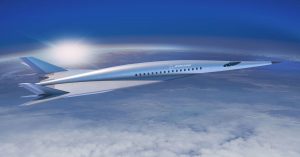 Boeing is one step closer to making a two-hour flight trip from New York City to London a reality. Currently, a typical commercial airliner takes about seven hours to make this trip. That number could be shaved down to just two hours, however, if Boeing achieves its objective. The American aerospace company says it wants to create a supersonic jet that’s capable of flying faster than the speed of sound, thereby signaling a new era in the world of commercial air travel.
Boeing is one step closer to making a two-hour flight trip from New York City to London a reality. Currently, a typical commercial airliner takes about seven hours to make this trip. That number could be shaved down to just two hours, however, if Boeing achieves its objective. The American aerospace company says it wants to create a supersonic jet that’s capable of flying faster than the speed of sound, thereby signaling a new era in the world of commercial air travel.
While Boeing has yet to reveal an actual prototype of its hypersonic jet, the aerospace company recently unveiled a concept rendering of it. As shown in the image to the left, it features a sleek, aerodynamic design with webbed wings. Boeing revealed this design when speaking at a conference in Georgia earlier this month, providing aerospace enthusiasts with a sneak peak into its supersonic project.
Aside from its sleek design, though, the real beauty of Boeing’s proposed supersonic jet is its speed. A typical 747 has a cruising speed of about 550 miles per hour (mph), which is pretty fast compared to land-based vehicles. However, Boeing’s supersonic jet could fly as fast as 3,900 mph — several times faster than existing commercial aircraft. To put that speed into perspective, it would allow passengers to travel from New York City to London is just two hours or Los Angeles to Tokyo in about three hours.
Developing a hypersonic jet won’t be easy, nor will it be cheap. According to various report, Boeing will likely spend billions of dollars on the project, leaving many people wondering how the aerospace company will fund it. Given Boeing’s recent success in its battle for air domination with competitor Airbus, however, cashflow isn’t a problem for the company — not now, at least. With orders for its 767s pouring it, Boeing should have more than enough cash on hand to fund its hypersonic jet project.
So, when can you expect to see Boeing’s supersonic jet in the skies? While the project certainly sounds bold, Boeing is working aggressively to make it happen. When speaking about the project, Boeing’s Dennis Muilenburg told CNBC that it will likely be completed within the next two decades.
“I think in the next decade or two you’re going to see them become a reality,” Said Dennis Muilenburg. “We see future innovations where you could connect around the world in about two hours.”



